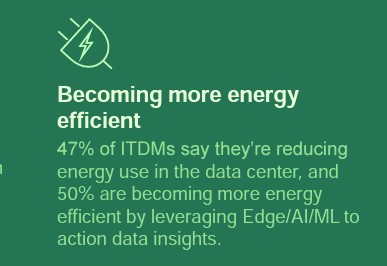By Jeff Boudreau, president of infrastructure solutions group (ISG), Dell Technologies
It used to be that sustainability initiatives were tucked into environmental stewardship campaigns, outside the purview of the enterprise’s bottom line.
But all that is changing—fast. The meteoric growth of power-hungry technologies like artificial intelligence, the unpredictability of weather-related power demands and the steep cost of utilities are forcing businesses to reevaluate how they look at energy efficiency.
Enterprises are realizing that going green saves green. Energy efficiency equals cost containment. And they’re putting their data management strategies under the microscope. A holistic approach that eliminates inefficiencies in workloads, hardware and data footprint delivers the most savings in energy—and money. And it’s based on multicloud computing strategies that place the data center front and center in IT operations.
The case for multicloud
 In the long-standing debate about cloud use, the chips are falling in favor of multicloud. Public cloud-only options might seem appealing as an external entity shoulders the responsibility of maintenance, but it has worrisome disadvantages. Public cloud forces enterprises to cede control and become reliant on a third-party’s roadmap. And the availability of computing resources, even with hyperscalers, is not guaranteed.
In the long-standing debate about cloud use, the chips are falling in favor of multicloud. Public cloud-only options might seem appealing as an external entity shoulders the responsibility of maintenance, but it has worrisome disadvantages. Public cloud forces enterprises to cede control and become reliant on a third-party’s roadmap. And the availability of computing resources, even with hyperscalers, is not guaranteed.
On the other hand, multicloud computing puts enterprises in the driver’s seat: It enables enterprises to place workloads where they make the most sense and gives them more control over their data strategies. It also makes room for innovation: Forty-three percent of more than 6,000 IT and business decision-makers from around the world, are embracing a mix of public and private cloud environments to achieve agility and innovate, according to the Dell Innovation Index.
A holistic approach to data management

If multicloud computing is the way to go, enterprises must bear the onus of operating on-premises data centers, and they need a holistic approach to rein in energy costs. Given IT’s very real energy-guzzling appetite, piecemeal approaches to sustainability and energy efficiency won’t do.
Enterprises need to reboot their processes and reevaluate every operational aspect with an eye toward efficiency. There’s a growing awareness of the need for such efficiencies: Forty-seven percent of information technology decision-makers (ITDMs) say they’re reducing energy use in the data center.
A holistic approach to reduced energy consumption might include the following strategies.
- Audit infrastructure
Businesses need to conduct a comprehensive evaluation of all IT equipment and identify the most power-hungry ones. Replacing these with more energy-efficient devices will help. Consolidating infrastructure by improving the density of equipment–packing more into less–decreases the physical and carbon footprint of computing machines.
- Consolidate workloads
Instead of spinning up virtual machines (VM) all the time, enterprises can look out for VM sprawl and underutilized servers. Consolidating workloads and physical infrastructure can positively impact energy efficiency.
- Reduce data footprint
Storage arrays are energy guzzlers, but they needn’t be. Data can be offloaded to cold storage and their footprint lowered with compression technologies. Too often, software teams proliferate data without proper deduplication procedures, which leads to excessive storage and high energy requirements.
- Leverage equipment’s inherent green capabilities
Advancements in fan technologies, liquid cooling and different heating, ventilation and air conditioning (HVAC) strategies can reduce energy consumption. For example, variable speed fans can adjust as central processing unit (CPU) usage and temperatures change and maintain optimal system temperatures without compromising performance. Modular data centers mix and match necessary components to incorporate cutting-edge cooling technologies to improve power usage effectiveness (PUE) numbers.
- Use services on demand
Using data and energy services only as needed helps cut the overhead of running all systems on maximum load all the time. Enterprises eliminate wasteful over-provisioning by using as-a-service options. They also offload lifecycle management, saving time spent on decommissioning and retiring hardware. More enterprises are recognizing the value of as-a-service options: Forty-two percent of those surveyed for the Dell Innovation Index are experimenting with energy use as a service to manage energy consumption.
6. Achieve transparency
Given the various ways in which energy inefficiencies can creep up, it helps to have a more centralized way of tracking them down. Technology can fill in the missing pieces of the puzzle. Thirty-nine percent of the respondents in the Dell Innovation Index are turning to technology to gain greater visibility of their carbon impact.
Technology not only facilitates visibility, but it also enables enterprises to make data-based decisions on where to cut energy costs—and how. Telemetry data from machines can provide fine-tuned insights into the best combinations of energy-efficient, high-performance machines so they use power only as needed.
A green foundation for tomorrow
Most decisions related to IT investment, especially when forming a multicloud strategy, are based on security, performance and cost. When assessing the energy efficiency of a multicloud strategy, it’s also important to factor in environmental, social and governance (ESG) standards.
Creating a green data center involves progress along many fronts: efficient hardware configuration, optimized cooling technologies and workloads, intelligent platform management and prompt decommissioning of retired equipment.
Enterprises need to fire on all cylinders instead of simply tinkering at the edges. They can harvest the low-hanging fruit and initiate a top-down sustainability transformation.
A multicloud computing strategy with an energy-efficient data center as its anchor delivers the agility and resources that companies need while optimizing ongoing utility expenses. Such a modern cloud infrastructure is exactly what spurs innovation: Innovators are 1.6 times more likely to achieve the outcomes they need–faster–with a modern cloud infrastructure.
It has never been a better—and more necessary—time for IT to embrace sustainability.

